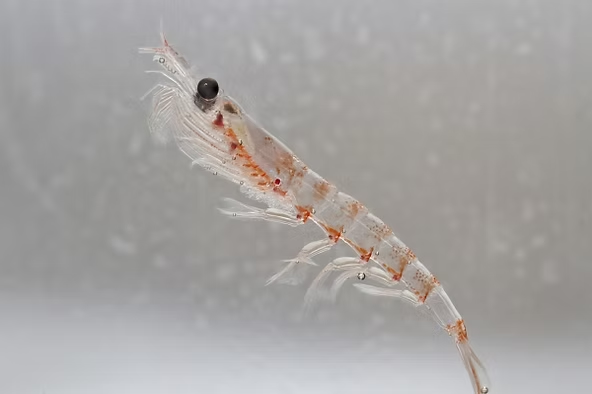Krill: Tiny Creatures with a Giant Role
Until recently, many of us only knew krill as “whale food.” But these tiny planktonic crustaceans are so much more than that. Norwegian for “small fry of fish,” krill may not sound impressive at first, yet their importance to ocean ecosystems is enormous.
Life in Swarms
Krill have transparent bodies, grow to about two inches long, and travel in massive swarms—sometimes as dense as 30,000 individuals per cubic meter! This group behavior helps protect them from predators.
Daily Ocean Migrations
To avoid predation, krill perform diurnal vertical migrations. At night, they rise to the ocean surface to feed on nutrient-rich phytoplankton, then retreat to deeper waters during the day. Some species repeat this journey multiple times a night.
The Favorite Meal of Giants
Blue whales feed almost exclusively on krill—up to four tons in a single day! Despite this, krill populations remain abundant thanks to their prolific reproduction. A single female can release up to 10,000 eggs, which hatch nearly 1,000 meters below the surface. From there, krill larvae migrate upward for their first taste of phytoplankton.
Antarctic Krill: Keystone of the Southern Ocean
With more than 85 krill species worldwide, Antarctic krill (Euphausia superba) stand out as a keystone species. They redistribute vital nutrients like iron through their migrations—feeding on ice algae near the surface and fertilizing the ocean with nutrient-rich waste as they descend. Their role sustains penguins, seals, whales, and countless other marine species.
Climate Challenges Ahead
Krill may be small, but they’re vulnerable to climate change. Their eggs are sensitive to ocean acidification, and their survival depends on sea ice. Scientists warn that Antarctic krill habitat could decline by as much as 80% by 2100 due to shrinking ice. Less sea ice means less ice algae, fewer krill, and cascading impacts across the Antarctic food web.
A Tiny Species with a Mighty Impact
Though at the bottom of the food chain, krill are among the most abundant creatures on Earth—and absolutely vital to ocean life. In other words, they’re truly “krillin’ it.”

